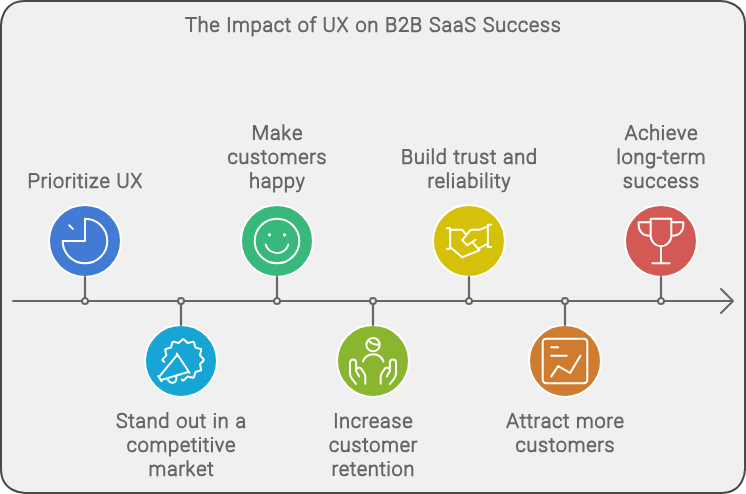UX Design for SaaS Growth: Strategies to Elevate B2B User Experience

Did you know 88% of online consumers won’t return to a website after a bad experience? Especially in B2B SaaS, UX matters a lot. It affects customer happiness, keeps them returning, and boosts the business. Think of UX as the bridge connecting users to the software’s cool features. A well-designed UX is more than good looks. It ensures everything works smoothly.
Knowing how UX plays a key role is vital for a B2B SaaS marketer. It helps create better engagement, loyalty, and business growth. When you focus on UX, your B2B SaaS stands out. It offers a unique and easy-to-use experience, making your customers pick you over others.
Understanding User Experience (UX) in B2B SaaS
In the B2B SaaS world, knowing about user experience (UX) is key. It’s about how users connect with a product or service, including their journey using a product’s interface. UX is critical for B2B SaaS success, improving customer happiness and loyalty and boosting business growth.
What is User Experience?
User experience (UX) is how someone feels about using a product or service. It looks at things like simplicity, looks, and even emotions. For B2B SaaS, making interactions that are easy, enjoyable, and efficient is vital. Good UX helps companies stand out, build stronger client relationships, and grow over time.
UX Elements in B2B SaaS
In B2B SaaS, making things easy to use matters a lot. This includes simple navigation, designs that fit any screen, and custom interfaces. These make the experience both nice to look at and useful. Companies focusing on these areas win by making their customers happy and loyal.
The Difference Between UX and UI
UX and UI are often confused, but they’re different yet work together in B2B SaaS. UX cares about the whole user journey, from start to finish. UI is about the look and feel of the interface, making sure it’s user-friendly. The best B2B SaaS companies ensure UX and UI match well, creating a great experience for business customers.
The Significance of UX in B2B SaaS Marketing
UX defines every way users interact with a service or product. It is crucial for the success of B2B SaaS companies. Good UX leads to happy customers and more successful businesses.
UX directly affects customer satisfaction. A design that is easy to use and understand makes the software more approachable. This ease of use helps users learn quickly and get the most out of the product. As a result, users are happier, which keeps them coming back. It’s key for maintaining long-term customers.

A positive experience also means users trust the brand more. If a SaaS product is a joy to use, customers see the company as reliable. They know the brand is dedicated to serving them well. This trust is a significant advantage in a busy market. It helps B2B SaaS companies get and keep more customers.
Great UX is necessary in a world where B2B SaaS companies face much competition. By focusing on user experience, companies can stand out, make customers happy, and keep them returning. Prioritizing UX helps businesses succeed over the long term.

Why is UX design important in SaaS?
A seamless UX isn’t just nice to have—it’s a game-changer for SaaS success. When a platform is visually appealing and effortless to navigate, users engage faster and stick around longer. A frictionless onboarding process reduces churn, while intuitive design keeps users exploring, discovering value, and building trust in your product. Personalized touches and smooth workflows create a connection, nudging users toward key actions like upgrades and referrals. The easier you make it for users to succeed, the more likely they are to convert. Prioritize UX, and growth will follow.
How UX Impacts SaaS Success
- Enhances User Adoption: A well-designed UX ensures users interact with the software effortlessly without feeling lost or overwhelmed. The interface is intuitive, making it easy to navigate and understand without requiring extensive training or detailed onboarding. When users can get started quickly and confidently, they’re more likely to stay engaged and thoroughly explore the platform’s features, leading to a better overall experience.
- Increases Customer Retention: A smooth and intuitive user experience keeps users returning, increasing long-term engagement with the software. However, research shows that 80% of users leave a site if it doesn’t display correctly on their device. This highlights just how important a responsive and user-friendly design is—ensuring that every user, no matter what device they’re on, has a seamless and frustration-free experience.
- Return on Investment: Forrester Research reports that investing in UX design isn’t just improving usability but also making a sound business decision. According to estimates of the ROI of UX, every dollar spent on UX returns $100, which is a fantastic 9,900% return on investment. This reflects that when businesses focus on a smooth user experience for their customers, it increases customer satisfaction and generates high business growth and profitability.
- Impact on Conversion Rates: A well-designed interface doesn’t just make a product look good—it makes it easier for users to take action. A good UI can boost conversions by up to 200%, and focusing on overall UX design can push that number to 400%. Simply put, more people stick around, engage, and convert when a product is easy to use and enjoyable.
- First Impressions and User Trust: First impressions matter—a lot. Research shows that 94% of first impressions come from a software’s design, making an exemplary user interface essential. Additionally, 75% of users decide whether a company is trustworthy by looking at its website. Speed is just as important as looks. More than half of mobile users (54%) will leave a site if it takes longer than three seconds to load. This highlights why UX design isn’t just about appearance—creating a smooth, fast, and reliable experience that engages users.
- Competitive Advantage: Almost half (45.9%) of businesses plan to focus on improving customer experience in the next five years. This shows that companies understand the power of good UX design in staying competitive. A seamless, user-friendly experience isn’t just a nice-to-have—it’s a key driver of customer loyalty, satisfaction, and long-term success.
- Reduces Support Costs: A well-designed user experience makes navigation simple and intuitive, reducing confusion and minimizing the need for customer support. When users can easily find what they need and complete tasks without frustration, they ask fewer questions—leading to lower support costs and a more efficient business operation.
Enhancing Customer Satisfaction and Loyalty
A positive user experience (UX) in B2B SaaS makes customers happier and can boost their stay with a service. If customers find a SaaS platform that is easy to use and share it with others, it’s a win.
Improving User Satisfaction
Focusing on good UX helps B2B SaaS firms meet their customers’ needs. Making sure the services are smooth and easy to use is key. Users love it when a SaaS tool makes their work easier, which boosts their happiness and keeps them around.
Building Trust and Credibility
Good UX also builds trust in SaaS companies. Customers trust the provider more When they easily find what they need and finish their jobs. This trust leads to better customer connections and more recommendations to friends.
Boosting Customer Retention
Improving UX can keep customers using B2B SaaS services for longer. Happy customers stay and help businesses grow. Keeping the user experience better always keeps the business on the right track.
The Importance of User Experience in B2B SaaS Marketing
In B2B SaaS, making things easy for users is key. This includes smooth workflows, simple interfaces, and easy learning. Doing this boosts the work done, smooths tasks, and saves businesses time and money.
Optimizing Workflows
Better workflows mean getting more done in B2B SaaS. When everything is planned out well, work goes smoother. This helps work get done quicker and saves companies time and money.
User-Friendly Interface
For B2B SaaS to work well, it must be easy to use. If the software is easy to understand, people use it better. This leads to more use and happy employees.
Streamlining the Learning Experience
The software can have many features in B2B SaaS. Making it easy to learn is very important. This is done by having clear start guides and help available. With these, customers understand and use the software better.

UX Design Strategies for Conversion Optimization
To boost conversions, B2B SaaS companies need a smart plan. This plan should blend with the core ideas of SaaS sales, marketing, and digital strategies. Together, these elements power up the potential of UX.
User-Centered Design Approach
Putting users first is key to B2B SaaS success. Companies need to meet the wants and needs of their audience. By deep-diving into user research and testing, they craft experiences that truly connect. This strategy lifts SaaS content and email marketing, enhancing customer loyalty and conversions.
Data-Driven Decision Making
Data is vital for B2B SaaS’s UX. It shows what users prefer and what works well. By acting on this data, companies can polish their products. This fine-tunes their marketing strategies and ensures the final products meet market demands.
Personalization and Inclusive Design
Diving into personalization and inclusivity powers up conversion rates. It makes every user’s experience unique and inviting, driving engagement. By focusing on inclusive design, there’s a wider potential customer reach. This increases sales and boosts marketing outcomes in the B2B SaaS world.
SaaS UX Best Practices
Since user experience has proven to be essential for the success of SaaS, the best practices that help in achieving advantageous and favorable outcomes are:
Simplify Navigation
Ensure that the users can find what they are looking for without unnecessary navigation and in minimum number of clicks. A well-organized navigation system increases user satisfaction and efficiency.
Prioritize Accessibility
Make the design inclusive so all users can access the product, including those with disabilities. This broadens the customer base and also complies with legal requirements.
Implement Responsive Design
Ensure the software can be effectively accessed across various devices and screen sizes. As many users are moving towards mobile devices, responsive design has become essential for an efficient user experience.
Enhance Performance
Slow performance can lead to frustration among users. Hence, ensuring that the application is fast and efficient is a must. Make sure to work on optimizing loading time.
Gather and Implement User Feedback
Regularly collect user feedback and information through surveys and analysis and implement them to constantly improve and be involved in changing user needs.
Unravel the Latest SaaS Trends in UX Design
Keeping up to date with the latest trends in UX design is essential for SaaS businesses looking to boost their user experience and give themselves a competitive edge. The newest trends influencing the UX environment in the SaaS sector are:
Low-Code Development Integration
The coming of low-code platforms enables users to customize and work on their SaaS applications with little experience or expertise in coding practices. This allows the users to personalize their experiences, bringing engagement and an enhanced sense of satisfaction.
Artificial intelligence and Personalization
Incorporating Artificial Intelligence allows users to personalize their experiences, such as customized dashboards and predictive analytics. This improves engagement by making relevant content and functionalities accessible to the users.
Vertical SaaS Solutions
Vertical SaaS refers to designing SaaS products personalized for specific industries. This ensures that the user experience aligns closely with industry-specific workflows and requirements. Horizontal and Vertical SaaS have been differentiated below:
Emotional Design
A design that the users can connect to improves engagement. It helps to build a connection between the users and the business. Thoughtful use of colors, imagery, and content can help design a design that evokes positive emotions, enhancing user experience, engagement, and loyalty.
Gamification Elements
Including elements of gamification strategies, like badges and leaderboards, can make the user experience more engaging and fun, encouraging repeated user usage. This, thereby, increases user retention.
Advanced Bot Management Design
Incorporating sophisticated bot management improves interaction between users and AI-driven platforms. This makes sure the user experience is smooth and effective.
Motion and Crisp Typography
Using motion graphics and crisp and clear typography can bring attention to the design and ensure the information reaches the users. It also creates a polished look that enhances the overall user experience.
Conclusion
The B2B SaaS industry is constantly changing. User experience (UX) plays a massive role in marketing now. It helps make customers happy and keeps them coming back. It’s key for B2B SaaS companies to understand UX by focusing on elements and the differences between them and UI.
UX makes B2B SaaS marketing better in many ways. It helps make workflows better and designs more straightforward to use. Taking a user’s view, using data in decisions, and making designs personal can boost sales. This means you stand out in the B2B SaaS market.
Remember, your experience is essential in B2B SaaS sales and marketing. Choosing UX first can lead to better customer relationships and more sales. It’s about setting your B2B SaaS business up for success over time.
Sources
- FounderJar
- Ecommerce Bonsai

 11 min read
11 min read










